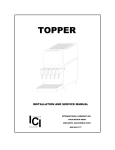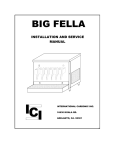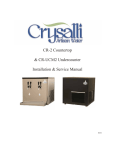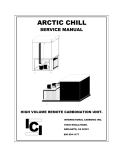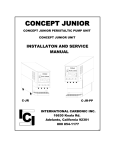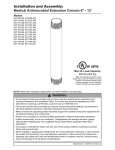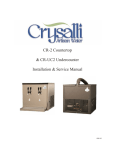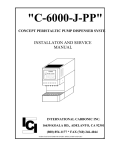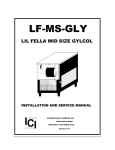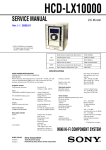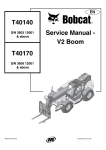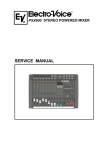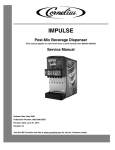Download International Carbonic Lil Fella - Soda
Transcript
LIL FELLA INSTALLATION AND SERVICE MANUAL LF-23 LF-12 ICI INTERNATIONAL CARBONIC INC. 16630 Koala Rd. Adelanto, CA 92301 800 854-1177 1/2/3 IMPORTANT: This manual is a guide for installing, operating, servicing and maintaining this equipment. Refer to Table of Contents for page location of detailed information to answer questions that arise during installation, operating, service and maintenance, or installation of this equipment. TABLE OF CONTENTS PREFACE PAGE 1 CHAPTER I GENERAL DESCRIPTION SYSTEM DESCRIPTION THEORY OF OPERATION 1-1 1-1 1-11 CHAPTER II INSTALLATION UNPACKING AND INSPECTION SELECTING LOCATION LOCATION RECOMMENDATIONS FOR LIL FELLA INSTALLATION INSTALL COOLING UNIT INSTALL HIGH PRESSURE CO2 REGULATOR, CO2 CYLINDER AND LINES INSTALL LOW PRESSURE REGULATOR AND LINES INSTALL WATER FILTER ASSEMBLY, (OPTIONAL) INSTALL WATER PRESSURE REGULATOR, (OPTIONAL) INSTALL WATER HOLDING TANK, (OPTIONAL) INSTALL DRAIN LINE INSTALL B.I.B. OR SYRUP TANKS AND ACCESSORIES CONNECTING WATER INLET ELECTRICAL REQUIREMENTS 2-1 2-1 2-1 2-2 2-2 2-2 CHAPTER III, PREPARATION PREPARING SYSTEM FOR OPERATION PREPARING AND STARTING REFRIGERATION UNIT PURGE DISPENSING VALVES ACTIVATE HIGH PRESSURE CO2 SYSTEM ACTIVATE LOW PRESSURE CO2 GAS AND SYRUP SYSTEMS ADJUST WATER FLOW RATE ADJUST WATER-TO-SYRUP “RATIO” ADJUST SIZE OF DRINK DISPENSED 3-1 3-1 3-1 3-1 3-1 3-2 3-2 3-2 3-2 CHAPTER IV OPERATORS INSTRUCTIONS DAILY PRE-OPERATION CHECK REPLENISHING CO2 SUPPLY REPLENISHING SYRUP SUPPLY COOLING UNIT MAINTENANCE CHECKING WATER BATH CHANGING WATER BATH ADJUSTMENTS ADJUSTING WATER FLOW RATE ADJUSTING WATER-TO-SYRUP “RATIO” OF DISPENSED PRODUCT ADJUSTING SIZE OF DRINK DISPENSED TESTING FOR LEAKS 4-1 4-1 4-1 4-1 4-1 4-2 4-2 4-2 4-2 4-2 4-2 4-2 CHAPTER V SERVICE AND MAINTENANCE PERIODIC INSPECTION AND CLEANING LIL FELLA CABINET MAINTENANCE CLEANING CONDENSER COIL CHECKING/CHANGING WATER BATH WATER PUMP MAINTENANCE CARBONATOR MAINTENANCE LUBRICATION SERVICING CHECK VALVES REPLENISHING CO2 SUPPLY 5-1 5-1 5-2 5-2 5-2 5-3 5-4 5-4 5-5 5-7 2-3 2-3 2-4 2-4 2-4 2-5 2-5 2-5 2-5 TABLE OF CONTENTS (cont’d) SYRUP FLAVOR CHANGE CHANGING WATER FILTER CARTRIDGE (OPTIONAL) ADJUSTMENTS HIGH PRESSURE CO2 REGULATOR LOW PRESSURE CO2 REGULATOR DIET SYRUP TANK CO2 REGULATOR BRIX INSTRUCTION CLEANING AND SANITIZING CHAPTER VI TROULBESHOOTING COOLING UNIT WATER PUMP MOTOR WILL NOT OPERATE WATER PUMP MOTOR WILL NOT SHUT OFF WATER PUMP WILL NOT SHUT OFF AND PRESSURE RELIEF ENGAGED SHORT CYCLING OF WATER PUMP MOTOR WATER PUMP CAPACITY TOO LOW WATER PUMP OPERATES BUT WATER PUMP DOES NOT PUMP FROZEN WATER BATH COOLING OR CONDENSING UNIT NOT OPERATIONAL AGITATOR MOTOR NOT OPERATING COMPRESSOR DOES NOT OPERATE COMPRESSOR WORKS CONTINUOUSLY BUT DOES NOT FORM SUFFICIENT ICE BANK COMPRESSOR WILL NOT STOP AFTER SUFFICIENT ICE BANK IS PRODUCED CONDENSER FAN MOTOR NOT OPERATING DISPENSING VALVES WATER OR SYRUP LEAKING FROM NOZZLE AFTER ACTUATION NO WATER, NO SYRUP BEING DISPENSED FROM VALVE NO SYRUP BEING DISPENSED NO WATER BEING DISPENSED DISPENSED PRODUCT CARBONATED TO LOW DISPENSED PRODUCT MAKES FOAM AS IT LEAVES NOZZLE DISPENSED PRODUCT COMES OUT CLEAR BUT FOAMS WHEN IT TOUCHES CUP OR GLASS WATER-TO-SYRUP “RATIO” TOO LOW OR TOO HIGH ADJUSTMENT OF SYRUP METERING PIN DOES NOT PRODUCE DESIRED WATER-TO-SYRUP “RATIO” CARBONATION TROUBLESHOOTING FLOW CHART #1 CARBONATION TROUBLESHOOTING FLOW CHART #2 CARBONATION TROUBLESHOOTING FLOW CHART #3 NOTE SECTION PAGE 5-7 5-7 5-7 5-7 5-8 5-8 5-9 5-11 6-1 6-1 6-1 6-1 6-1 6-1 6-1 6-2 6-2 6-2 6-2 6-2 6-2 6-3 6-3 6-3 6-3 6-4 6-4 6-4 6-4 6-4 6-4 6-5 6-5 6-6 6-7 6-8 6-9 LIST OF FIGURES Figure Title 1-1 1-2 1-2 1-3 1-4 EXPLODED VIEW OF LIL FELLA-12 ILLUSTRATED PARTS BREAKDOWN OF LIL FELLA 12 ILLUSTRATED PARTS BREAKDOWN OF LIL FELLA 12 Cont EXPLODED VIEW OF LIL FELLA-23 ILLUSTRATED PARTS BREAKDOWN OF LIL FELLA 23 1-3 1-4 1-5 1-6 1-7 TABLE OF CONTENTS (CONT’D) Figure Title PAGE 1-4 1-5 1-6 2-1 2-2 2-3 2-4 5-1 5-2 5-3 ILLUSTRATED PARTS BREAKDOWN OF LIL FELLA 23 Cont ELECTRICAL SCHEMATIC 110V ELECTRICAL SCHEMATIC 24V SAMPLE OF A POSSIBLE INSTALLATION HIGH PRESSURE CO2 REGULATOR, (S-101) LOW PRESSURE CO2 REGULATOR, (S-121) SUGGESTED WATER FLOW INSTALLATION WATER PUMP, “Y” STRAINER & SCREEN CHECK VALVES COMPOSITE EXPLODED VIEW OF CHECK VALVES AND RELIEF VALVE 1-8 1-9 1-10 2-2 2-3 2-3 2-4 5-5 5-6 5-7 LIST OF TABLE 1-1 2-1 DESIGN DATA LOOSE-SHIPPED PARTS 1-1 2-1 PREFACE INTERNATIONAL CARBONIC INC. has enjoyed over 53 years of manufacturing excellence in the field of carbonation and in the beverage related industry. We have had a long and proud history with quality as our standard and innovation as our goal. Originally started just after World War II in Canfield, Ohio as Carbonic Dispensers. We enjoyed patents on the first Sodajet type carbonator. This method of carbonation instantaneously carbonated the water to 100% saturation. We developed the first patented dispensing valve to dispense bulk beverage with carbonation equal to or in excess of bottled beverages. A valve with three flavors and soda was another first. We were the first to incorporate the total postmix package, i.e., carbonation, refrigeration, and the ability to dispense from one self contained unit. We have pioneered many such firsts and will continue to develop advanced systems for the future, such as electronic interrogatable portion controls to electronic liquid level controls. We hope you enjoy this piece of equipment that has been produced to give many years of trouble free service. We thank you for your purchase and hope we may serve you in the future. 1 CHAPTER I GENERAL DESCRIPTION This chapter gives the description, theory of operation, and design data for the LIL FELLA 12 or LIL FELLA 23 and related components. The LIL FELLA 12 or LIL FELLA 23 utilizes one cabinet but can be manufactured in many configurations. The following data will refer to of the basic types of configuration: The LIL FELLA-12 and the LIL FELLA-23 utilizes one cabinet. The valves can be mounted on the narrow or long side of the cabinet. If mounted on the narrow or 12” side the unit will be referred to as a LF-12. If the valves are mounted on the wide or 23” side the unit will be referred to as a LF-23. If data refers to both types we will refer to the unit as LIL FELLA. SYSTEM DESCRIPTION The LIL FELLA is a complete beverage dispenser and when combined with related components, will produce a variety of cooled carbonated and non-carbonated beverages. The LIL FELLA consists of a condensing unit, a water reservoir, water-cooling coil, a carbonator tank, (carbonated systems only), an agitator pump, and optional syrup cooling coil(s) and dispensing valve(s). For proper function the LIL FELLA must have a water supply, and electrical supply and drainage. The LIL FELLA is designed with a unique lift off drain pan that can be emptied at any convenient drain outlet. Other items that will be required if used in B.I.B., (Bag in Box), or transfer tank, (FIGAL), installations will be High pressure regulator, Low pressure regulator, connecting lines, quick couplers, or disconnects and C02. WARNING: Before shipping or relocating a LIL FELLA into a freezing ambient environment empty plain and carbonated water. Syrup systems should be flushed, ice bank melted, and water drained from water bath. A freezing ambient environment will cause existing water in unit to freeze possibly resulting in damage to pump/motor assembly, syrup coils, water coil, water bath, valve(s), etc. TABLE I - I DESIGN DATA COOLING UNIT Overall cabinet dimensions: LF-12 LF-23 LF-12-J LF-23-J Height ................................24 1/2” .............. 24 1/2”.............. 24 1/2”.............. 24 1/2” Width ..................................12 1/4” .............. 13 3/8”.............. 12 1/4”.............. 13 3/8” Depth..................................24 3/8” .............. 23 3/16”............ 24 3/8”.............. 23 3/16” Weights: Shipping .............................140 LBS. .......... 140 LBS. .......... 113 LBS. .......... 113 LBS. Dry weight ..........................111 LBS. .......... 111 LBS. .......... 88 LBS. ........... 88 LBS Operational Weight ............153 LBS. .......... 153 LBS. .......... 130 LBS. .......... 130 LBS. Ice Bank .............................9 LBS. .............. 9 LBS. .............. 9 LBS. ............. 9 LBS. 1-1 Capacities: Unit water bath (no ice bank)..... ......................... 4 gallons Refrigerant requirement (R-134-A) ......... ......................... ......................... 165 grams Ambient operating temperature .............. ......................... ......................... 40 F to 100 F. Electrical Requirements: The cooling unit requires a 115 VAC, single phase, 60 Hertz power circuit. Circuit Ampacity ............9.6 Amps .......... 9.6 Amps.......... 3.4 Amps.......... 3.4 Amps Condensing Unit............2.1 Amps .......... 2.1 Amps.......... 2.1 Amps.......... 2.1 Amps Water Pump Motor ........6.2 Amps .......... 6.2 Amps.......... NA .................... NA Transformer....................5 Amps .......... .5 Amps.......... .5 Amps.......... .5 Amps Agitator...........................8 amps .......... .8 amps .......... .8 amps .......... .8 amps Water Filter Recommended (Optional) See Manufacturer Specifications for Operating Conditions Pressure Incoming Water Pressure Regulator (Optional) .......................................... 25 – 40 C02 High Pressure Regulator (Carbonated units only) PSI........................ 70 – 75 C02 Low Pressure Regulator (Carbonated/Flavored units only) ................ BIB Approx. 40 PSI C02 Low Pressure Regulator (Carbonated/Flavored units only) ................ FIGAL Approx. 30 PSI C02 Low Pressure Regulator (Optional) ..................................................... FIGAL Approx. 30 PSI C02 Diet Drink Pressure Regulator (if required) ......................................... 6 - 10 PSI DISPENSING VALVES Ambient Operating Temperature .......................... 40 F to 100 F Electrical Requirements: Operating Voltage .......................... 24VAC, 6Ohz 1-2 4 1 3 5 6 2 7 9 8 10 11 2 12 29 23 20 35 6 36 37 26 27 38 31 30 39 41 34 32 33 25 24 15 28 21 22 19 18 17 14 13 2A 16 40 47 43 42 48 45 44 56 49 46 58 57 55 59 60 61 62 63 64 50 INTERNATIONAL CARBONIC INC. 51 53 52 54 ICI ADELANTO, CALIFORNIA TITLE LF-12 LIL FELLA 12 POST MIX DATE 12/15/04 DRN. BY CHK. BY APPR. BY GLW FIGURE 1-1 1-3 LF-12 SYM QTY PART NO. DESCRIPTION 1 1 S0770 LID W/INSULATION 2 2 S0751 SERVICE PANEL, SIDE 2A 2 S0751-A 3 1 S0750 3A 1 S0750-A SERVICE PANEL AWNING, REAR 4 7 A0051-A RIVETS, BLACK 5 1 S0513-A ICE BANK CONTROL 6 3 A0020 7 1 S1304-U 8 1 S0739 STAND PIPE, 6 1/2", WHITE 9 1 S0738 OVERFLOW, 6 3/4", GRAY 10 1 S0835 AGITATOR PUMP 11 1 S0073-48 SERVICE PANEL AWNING, SIDE SERVICE PANEL, REAR 8-32 X 3/8 T.H. SCREWS, S.S. ICE BANK CONTROL BRACKET PROBE ASSEMBLY 12 2 S0741 EVAPORATOR COIL RETAINER 13 1 S0733 EVAPORATOR COIL ASSEMBLY 14 1 S0509 ACCUMULATOR, 4" VERTICAL 15 1 Z0009 CAP TUBE, 12' - .042 16 6 S0588-A SYRUP COIL 17 1 S0262-LF CARBONATOR TANK ASSEMBLY 18 3 H0020 "T" CLIP 3/8 X 5/16 19 1 S0684 WATER COIL, COPPER 20 1 S0208-A WATER REGULATOR, OPTIONAL 21 1 E0476-A TRANSFORMER 22 1 S1308 23 1 S0068-B 24 1 S1310 TERMINAL BOX COVER 25 4 S1335 TERMINAL BOARD SPACER, NYLON, 3/8" 26 7 S0046 BUSHING 27 1 E0664 STRAIN RELIEF 28 1 ..... MOISTURE BARRIER, 12 29 1 ..... INSULATION, LEFT 30 1 ..... INSULATION, REAR TERMINAL BOX WITH COVER LIQUID LEVEL CONTROL, LLC FIGURE 1-2 1-4 LF-12 Cont. 31 1 ..... INSULATION, FRONT 32 1 ..... INSULATION, RIGHT SIDE 33 1 ..... INSULATION, BOTTOM 34 1 ..... MOISTURE BARRIER, 23 35 1 S0667 WATER LINE, COPPER 36 1 S0203 UNION CONNECTOR 37 1 S0731 BUCKET COMPLETE W/INSULATION 38 3 A0046 5/16 X 18 FLANGE WHIZ LOCK SCREW, 3/4" 39 1 AEA1360YXAXA 40 1 AEA1360YXA 41 1 S0732 FRAME, COMPLETE 42 1 S0783 UNIT ON OFF SWITCH 43 1 S0768 SWITCH LOCK W/KEYS 44 1 S0769-5 45 11 46 5 A0014 PFC-II-QR CONDENSING UNIT, 1/5 H.P. COMPRESSOR ONLY VALVE PLATE SCREW, #10 X 1/2", TH SS DISPENSING VALVES 47 20 A0048 SCREW, #10 X 1/2", TH SS 48 16 S1325 SQUARE GROMMET NUT 49 1 S0765 LEGS, 4", SET OF 4 50 1 S1149-A 51 1 S1149 DRAIN PAN W/CUP REST 52 1 S0743 DRAIN PAN HARDWARE, SET 53 1 S1161 PLASTIC DRAIN OUTLET, 90 DEGREE 54 1 S1162-A 55 1 E0141-12 56 1 S0175 90 DEGREE ELBOW, 3/8 MP X 1/4 MF 57 1 S0103 PUMP PROTECTOR 58 1 S0170 HALF UNION BRASS, 3/8 MF X 3/8 MP 59 1 S0104 PUMP PROTECTOR BRACKET CUP REST FLANGE PLUG CORD 60 1 S0650 STRAINER, BRASS 61 2 A0045 5/16 X 18 FLANGE WHIZ LOCK SCREW, 1/2" 62 1 S0200 PUMP, CARBONATOR 63 1 S0106 CLAMP, V BAND 64 1 S0096 MOTOR, CARBONATOR FIGURE 1-2 Cont. 1-5 1 5 3 4 2 9 7 6 11 10 8 12 2 2A 13 14 18 15 17 19 16 20 27 21 28 22 24 29 23 31 32 25 33 30 26 35 34 11 41 42 54 51 52 44 62 56 57 58 46 61 55 53 45 60 59 50 43 63 INTERNATIONAL CARBONIC INC. 47 48 49 37 38 39 40 36 ICI ADELANTO, CALIFORNIA TITLE LF-23 LIL FELLA 23 POST MIX DATE 12/15/04 DRN. BY CHK. BY APPR. BY GLW FIGURE 1-3 1-6 LF-23 SYM QTY PART NO. DESCRIPTION 1 1 S0780 LID W/INSULATION 2 2 S0750 SERVICE PANEL, SIDE 2A 2 S0750-A 3 1 S0751 3A 1 S0751-A SERVICE PANEL AWNING, REAR 4 7 A0051-A RIVETS, BLACK 5 6 S0588-B SYRUP COIL 6 1 S0262-LF CARBONATOR TANK ASSEMBLY 7 1 S0073-48 PROBE ASSEMBLY 8 1 S0835 9 1 S0513-A ICE BANK CONTROL 10 1 S1304-U ICE BANK CONTROL BRACKET 11 3 A0020 8-32 X 3/8 T.H. SCREWS, S.S. 12 1 S0203 UNION CONNECTOR 13 1 S0667 WATER LINE, COPPER 14 1 S0684 WATER COIL, COPPER *** 1 S0208-A 15 2 S0741 EVAPORATOR COIL RETAINER 16 3 H0020 "T" CLIP 3/8 X 5/16 17 1 S0733 EVAPORATOR COIL ASSEMBLY 18 1 S0509 ACCUMULATOR, 4" VERTICAL 19 1 Z0009 CAP TUBE, 12' - .042 20 1 ..... MOISTURE BARRIER, 12 21 1 ..... INSULATION, LEFT 22 1 ..... INSULATION, REAR 23 1 ..... INSULATION, FRONT 24 1 ..... INSULATION, RIGHT SIDE 25 1 ..... INSULATION, BOTTOM 26 1 ..... MOISTURE BARRIER, 23 27 1 S0739 STAND PIPE, 6 1/2", WHITE 28 1 S0738 OVERFLOW, 6 3/4", GRAY 29 1 S0731 BUCKET COMPLETE W/INSULATION 30 1 S0732 FRAME, COMPLETE SERVICE PANEL AWNING, SIDE SERVICE PANEL, REAR AGITATOR PUMP WATER REGULATOR, NOT SHOWN, OPTIONAL FIGURE 1-4 1-7 LF-23 Cont. SYM QTY PART NO. DESCRIPTION 31 1 E0476-A TRANSFORMER, 55 VA 32 1 S1308 TERMINAL BOX WITH COVER 33 1 S0068-B LIQUID LEVEL CONTROL, LLC 34 1 S1310 TERMINAL BOX COVER 35 4 S-1335 TERMINAL BOARD SPACER, NYLON, 3/8" 36 7 S0046 BUSHING 37 1 E0664 STRAIN RELIEF 38 11 A0014 SCREW, #10 X 1/2", TH SS 39 1 S0765 LEGS, 4", SET OF 4 40 1 S0783 UNIT ON OFF SWITCH 41 1 S1330 SWITCH LOCK W/KEYS 42 1 S0779-6 43 20 A0048 44 5 PFC-II-QR 45 1 S1150-A 46 1 S0743 DRAIN PAN HARDWARE, SET 47 1 S1150 DRAIN PAN W/CUP REST 48 1 S1161 PLASTIC DRAIN OUTLET, 90 DEGREE 49 1 S1162-A 50 1 S0175 90 DEGREE ELBOW, 3/8 MP X 1/4 MF 51 1 S0103 PUMP PROTECTOR 52 1 S0104 PUMP PROTECTOR BRACKET 53 2 A0045 5/16 X 18 FLANGE WHIZ LOCK SCREW, 1/2" 54 1 S0170 HALF UNION BRASS, 3/8 MF X 3/8 MP 55 1 S0650 STRAINER, BRASS 56 1 S0200 PUMP, CARBONATOR 57 1 S0106 CLAMP, V BAND 58 1 S0096 MOTOR, CARBONATOR 59 16 S1325 SQUARE GROMMET NUT 60 1 E0141-12 61 3 A0046 62 1 AEA1360YXAXA 63 1 AEA1360YXA VALVE PLATE SCREW, #10 X 1/2", TH SS DISPENSING VALVES CUP REST FLANGE PLUG CORD 5/16 X 18 FLANGE WHIZ LOCK SCREW, 3/4" CONDENSING UNIT, 1/5 H.P. COMPRESSOR ONLY FIGURE 1-4 Cont. 1-8 S-68-B ELECTRICAL SCHEMATIC 120 VOLT FAN MOTOR C S 3 R M 1 1 S ICE BANK CONTROL COMPRESSOR TRANSFORMER GREEN GREEN WHITE 120 VAC BLACK ON/OFF ON/OFF INTERNATIONAL CARBONIC INC. POWER ON/OFF B1 G1 G2 G3 G4 A2 A3 A4 A5 B2 B3 B4 B5 IBC1 IBC2 MOTOR2 AGITATOR PUMP SHORT WHITE GREEN BLACK WHITE CONDENSING UNIT S-68-B MOTOR1 GREEN CU1 CU2 LONG GND BLACK GREEN ELECTRODE CARB GROUND TERMINAL SCREW IN CONTROL BOX Note: Ground Terminals, Carbonator Tank MOTOR/PUMP GREEN and Water Bath Must be Commonly Grounded NOTE: IF USING EXTRA 120V. ACCESSORIES SUCH AS RECIRCULATING MOTOR, ILLUMINATION ETC., MAKE CONNECTIONS AT TERMINAL A4, A5 FOR POWER/BLACK LEG. TERMINALS B4, B5, FOR NEUTRAL/WHITE LEG AND GROUND AT BOX OR ANY GROUND TERMINAL NOT IN USE. TERMINALSGROUND TERMINALS ARE G1, G2, G3, G4. FIGURE 1-5 1-9 VALVE SCHEMATIC BLACK RED C BLUE C NO NO NC NC WHITE C NO NC 24 VOLT WHITE YELLOW 24 VOLT SYRUP WATER SYRUP WATER SINGLE DUAL 24 VOLT VALVES KEY SWITCH 24 VOLT TRANSFORMER ELECTRICAL SCHEMATIC 24 VOLT FIGURE 1-6 1-10 THEORY OF OPERATION The LIL FELLA was designed to manufacture and dispense carbonated or noncarbonated beverages much like your local bottling plant that cans or bottles your favorite carbonated or non-carbonated drink. Initially water is chilled and then carbonated to dispense a quality drink. To chill the water the water is routed through a water coil that is submerged in an ice-cold water bath. The temperature of the incoming water is at ambient temperature as it enters the water coil. As the incoming water passes through the water coil the heat is removed from the water in the water coil and chilled to a temperature acceptable for a quality drink. In both cases, carbonated or juice drinks, this procedure is performed. If the LIL FELLA is a carbonated unit the water is now routed into a carbonator tank where this cold water is mixed with CO2. This water is now transformed into a carbonic acid, (soda water), and then routed to a valve where it will be mixed with a syrup concentrate and dispensed. In the case of the juice or non-carbonated drinks the carbonator tank is not needed so the chilled water is directed straight to the valve. Again it is mixed with a syrup concentrate and then dispensed. The water bath holds approximately 4 gallons of water. A certain amount of this water will be transformed into ice, approximately 9 pounds. This water reserve and ice bank will act as a reservoir for refrigeration. This reserve is utilized during peak periods when the BTU output of the compressor is not sufficient to meet the demand of the draw. It should be recognized that without refrigeration your carbonation system would not produce a drink that will hold carbonation. There is a direct relationship between dispensed temperature and the volumes of C02 that can be held in liquid form. The following will give a general overview of the flow of individual circuits and a clearer understanding of our mini bottling plant. Carbon dioxide gas (CO2) passes from a C02 cylinder through high-pressure regulator (S-101). The high-pressure regulator regulates the CO2 feeding the LIL FELLA and should be set at 70-75 PSI. The gas, after leaving the high-pressure regulator, is routed through flexible tubing to a low-pressure regulator. The flow of CO2 is teed to go in two directions at the low-pressure regulator. One path takes the gas, set at 70 to 75 PSI, to the carbonator tank. This gas must be at a pressure greater than the incoming water by at least 25-PSI to assure the proper function of the carbonator. The second path of C02 is routed through low-pressure regulator to be regulated at pressures suitable for the syrup concentrate being dispensed. The low-pressure regulator may be set at many different settings but primarily the settings are directed towards B.I.B. or transfer tank type installations. The average settings may vary from 10 to 60 PSI; this of course will be influenced by length of run, ambient temperature and baume of product. Typically B.I.B. installations are set at an average of 40 PSI and transfer tank installations are set at an average of 30 PSI. As discussed earlier plain water enters the LIL FELLA through the incoming water line. This water proceeds through the water coil where it is chilled prior to entering the carbonator tank or in the case of non-carbonated drinks chilled prior to going directly to a valve. Prior to entering the carbonator tank an optional regulator (S-208A) may be installed. This assembly is utilized to maintain water pressure feeding a non-carbonated valve when used in conjunction with carbonated valves. 1-11 The water source should be regulated, this is normally performed by the use of an in line water regulator. If the water is not regulated and the water pressure is equal or greater than the incoming CO2 the act of carbonation will be greatly inhibited or completely eliminated. At the proper settings, the gas pressure will stop the water from entering the carbonator tank. To force the water into the tank a liquid level control and motor/pump will be used. This combination will force the water into the tank mixing the water and CO2 together. The carbonator utilizes a Soda Jet Recirculating Principle. Our Company pioneered this principle in the early 1950's. This principle produces instantaneous carbonation at extremely large capacities of 100 gallons per hour minimum. The level of the carbonated water within the stainless steel mixing tank is used to operate the motor driven pump. The liquid level control, in conjunction with a probe housed in the carbonator tank, controls the pump motor. The motor will come on when the carbonated water within the mixing tank recedes to a predetermined low level and stops the pump motor when the carbonated water reaches a predetermined high level. During the cycle of operation, fresh water enters the carbonator tank through the soda jet after passing through the water pump. The water pump has impellers, which drives the water through the water coil then a dual check valve and then through the soda jet and into the carbonator tank. The position and angle of the soda jet is fixed to direct an extremely high velocity solid jet of fresh water so as to impinge upon the surface of the stored body of carbonator water within the stainless steel mixing tank. The force created by this jet of fresh water entering the mixing tank causes all the water within to cascade and foamesce through the carbon dioxide gas area in a continuous recirculating-manner. This action causes a breakdown of the surface tension of the water, forming numerous minute gases filled water bubbles. The micro thin walls of these water bubbles surrounded by gas both inside and out, offer maximum water surface for the absorption of the gas. The size opening through this jet permits large volumes of water to be carbonated. As the incoming water is being carbonated, the level within the tank rises to contact the upper probe tip, which will de-energize a relay on the liquid level control and stop the motor from turning the pump. This motor will be inactive until water within the tank recedes below the long probe tip, at which time, the relay on the liquid level control will close, engaging the motor once again. 1-12 CHAPTER II INSTALLATION This chapter covers unpacking and inspection, selecting location, installing LIL FELLA and related components, connecting water inlet and electrical requirements. UNPACKING AND INSPECTION Upon receiving unit, immediately remove unit from shipping carton and inspect for shipping damage. NOTE: Before leaving the factory all LIL FELLA units were carefully inspected and the carrier has accepted and signed for them. Any damage or irregularities should be noted at the time of delivery and immediately reported to delivering carrier. Request a written inspection report from claims inspector to substantiate any necessary claim. File claim with delivering agency, not International Carbonic Inc.! Unpack LOOSE-SHIPPED PARTS. At this time make sure all parts listed are present and in good condition. If any parts are missing, notify factory. TABLE 2-1 LOOSE - SHIPPED PARTS • Item No. 1 2* 3* 4 5 6 7 8* 9* 10* * Optional Part No. S-101 S-221 S-1149 S-1150 S-105 ----S-208 S-208A Name Installation/Service Manual High Pressure C02 Regulator Low Pressure C02 Regulator Drain pan LF-12 Drain Pan LF-23 6’ Gas Line (Inner Braid) Product Decals Water Pressure Regulator Water filter Water Pressure Regulator Qty 1 1 1 1 1 1 1 per flavor 1 1 1 SELECTING LOCATION IMPORTANT: Ambient temperature for LIL FELLA should not exceed 100 degrees “F”. Operation of cooling unit in ambient above 100 degrees “F” can and will contribute to early failure of condensing unit and poor quality of finished product. 2-1 LOCATION RECOMMENDATIONS FOR LIL FELLA 1. Position unit as close as possible to proper electrical source, 120V 60HZ. 2. Position unit with a minimum of 2” space between bulkhead and cabinet for sufficient ventilation. Allow enough space between ceiling and unit for lid removal. 3. Position unit as close as possible to water source. Half-inch gate valve recommended for water connection. 4. Enough space must be allowed to install C02 cylinder, syrup containers, racks, pumps, water filter, etc. 5. Position unit as close as possible to floor drain. FIGURE 2-1. SAMPLE OF POSSIBLE INSTALLATION. INSTALLATION INSTALL COOLING UNIT 1. Make all connections: C02 gas, plain water and syrups. 2. Place LIL FELLA in position. Make sure sufficient space between bulkheads, walls and overheads is available for proper air circulation around cooling unit. 2-2 INSTALL HIGH PRESSURE C02 REGULATOR, C02 CYLINDER AND LINES (FOR CARBONATED UNITS ONLY) 1. Install high pressure C02 regulator, (S-101) on C02 cylinder using a new seal gasket. MAKE SURE NEW WASHER IS INSIDE REGULATOR ASSEMBLIES COUPLING NUT BEFORE CONNECTING TO CYLINDER. WARNING-: To avoid personal injury and/or property damage, always secure C02 cylinder with safety chain to prevent cylinder from falling. It is recommended that the C02 cylinder be installed away from heavily traveled areas such as doors, passageways, corridors, etc. 2. Connect 1/4" inner braided plastic tubing from outlet of high pressure C02 regulator, (S-101), on C02 cylinder to Tee connection at low pressure regulator, (S-221), using prefabricated gas charging line, (S-105). 3. A line must be fabricated at this time. Cut inner braid tubing to size and install nipple, (S-145), and nut, (S-150), to each end of tubing making sure either oetiker or ferrule is previously installed on line. Secure these connections by use of proper tool. Connect ¼“, inner braid plastic tubing from outlet of tee at low-pressure regulator, (S-221), (optional furnished with unit); to supplied line from unit marked gas. INSTALL LOW PRESSURE REGULATOR AND LINES (OPTIONAL) 1. Install low pressure C02 regulator on the wall or another supporting structure in general vicinity of cooling unit, C02 cylinder, B.I.B. rack or syrup tanks. 2. Connect 1/4" inner braided plastic tubing from outlets of low pressure C02 regulator, (S-221), to inlets of B.I.B. pump or syrup tanks. 30 140 150 160 1000 1500 2000 3000 FIGURE 2-2 HIGH PRESSURE C02 REGULATOR REGULATOR (S-101) FIGURE 2-3 LOW PRESSURE C02 REGULATOR (S-221) 2-3 INSTALL WATER FILTER ASSY. (OPTIONAL) 1. Install water filter assembly on wall or other supporting structure. 2. Connect water filter assembly to inlet of valve on water supply line using minimum 3/8" I.D. water line. 3. Connect water filter assembly outlet to LIL FELLA plain water inlet fitting using minimum 3/8" I.D. water line. See CONNECTING WATER INLET. When a water filter is used, it is important that it has a minimum 100 gallons per hour capacity and should be thoroughly flushed before it is connected to the water inlet connection. INSTALL WATER PRESSURE REGULATOR (OPTIONAL) If water pressure exceeds 40 psi, a water pressure regulator or water pressure-reducing valve should be installed in the water supply line and adjusted to maintain a pressure of 25 to 40 psi. (The water regulator must have an orifice of at least 3/16” so as not to restrict the water flow through the valve. Valves that are built with 1/2" pipe thread connection usually have a sufficient orifice opening.) INSTALL WATER HOLDING TANK (OPTIONAL) When no water pressure is available or where the water supply system is inadequate, a water holding tank may be installed above the pump level. The pump will pump water from the holding tank to the carbonator. WATER REGULATOR 1/2" GATE VALVE WATER FILTER FIGURE 2-4. SUGGESTED WATER FLOW INSTALLATION 2-4 INSTALL DRAIN LINE 1. Connect drain line on LIL FELLA unit with drain using 3/8” I.D. clear plastic pipe or 3/8” copper tubing to nearest outlet. 2. Do not reduce drain connection from cabinet outlet. 3. Be sure all connections are watertight. INSTALL B.I.B. OR SYRUP TANKS AND ACCESSORIES (OPTIONAL) 1. Place B.I.B. or syrup tanks as close as possible to LIL FELLA unit, preferably no farther than 5 feet. 2. Lay out syrup lines from unit to syrup pumps or tanks. 3. Connect lines from low-pressure regulator for B.I.B. or transfer tank installations. 4. Connect line from low-pressure regulator to Q.C.D. for B.I.B. or install quick disconnect for transfer tank type installations. 5. Install incoming syrup line to unit on Q.C.D. for B.I.B. 6. Install quick disconnect on incoming line to accommodate transfer tank installs. 7. Activate Q.C.D. or install quick disconnects to transfer tanks. 8. Check all connections for leaks. (See Chapter IV) CONNECTING WATER INLET WATER PIPE CONNECTIONS AND FIXTURES DIRECTLY CONNECTED TO POTABLE WATER SUPPLY SHALL BE SIZED, INSTALLED AND MAINTAINED ACCORDING TO FEDERAL, STATE, AND LOCAL LAWS. The water connection on the LIL FELLA is made to a flexible water line by means of a 3/8”, male flare. Due to the large capacity of the pump, any restriction of the incoming fresh water supply would starve the water pump and create noise within the pump, poor carbonation and extremely long running time. After all primary water lines are made up, but prior to connecting water supply to cabinet, be sure to thoroughly flush all incoming water lines to remove all scale and any impurities that may be in the lines. It is important to remember that the LIL FELLA has a carbonator capacity of a minimum of 100 gallons per hour. Therefore, it is imperative that the fresh water conduit has not less than 3/8” I.D. passageway for any distance greater than ten feet from the LIL FELLA. It can be reduced to 3/8” O.D. copper tubing and connected to the water inlet connection with-in ten feet of the LIL FELLA. All water inlet connections are clearly tagged. ELECTRICAL REQUIREMENTS: The LIL FELLA requires a 120 VAC, single phase, 60-Hertz power circuit, and must be wired in accordance with N.E.C. or local ordinance. NOTE: Check CHAPTER I for running amperage and connect to appropriate electrical circuit. 2-5 CHAPTER III PREPARATION All steps in previous chapters should be understood and carried out before proceeding. PREPARING SYSTEM FOR OPERATION Be sure that electrical power is unplugged, valve on C02 cylinder is closed, and valve on water supply line is closed, and release pressure of C02 gas and water from carbonator tank. PREPARING AND STARTING REFRIGERATION UNIT 1. LIL FELLA refrigeration is pre-set at factory and ready to operate. 2. Remove lid. 3. Fill water bath with clean water until water runs out of condensate drain outlet, (S-739) above drain pan (approximately ½” from top of water bath). 4. Open water inlet supply line. 5. Plug LIL FELLA power cord into electrical receptacle box, turn power switch to the "ON" position. Make sure compressor, condenser fan motor, agitator motor start. The process of cooling the water bath will now commence. With ambient and water temperature of 75 degree “F” initial pull down or formation of complete ice bank will take approximately 3 hrs. When full ice bank has been formed, compressor and condenser fan motor will stop. Agitator will continue to operate, circulating water in water bath. PURGE DISPENSING VALVES Dispense water from dispensing valves until all air is purged from soda water and noncarbonated waterlines. ACTIVATE HIGH PRESSURE C02 SYSTEM 1. Open valve on the C02 cylinder. Be sure to open valve completely or until valve is back seated. 2. Turn high pressure C02 regulator screw clockwise until the pressure is 70 to 75 psi. Carbonated units only. 3-1 3. Dispense water from dispensing valves until the carbonator activates. Carbonated units only. 4. Allow carbonator to run until it automatically shuts off. Pump is fully primed and carbonator is now ready for use. Carbonated units only. 5. Check all connections on high pressure C02 system for leaks. Repair any leaks that are found. ACTIVATE LOW PRESSURE C02 GAS AND SYRUP SYSTEMS (OPTIONAL) 1. Make sure high pressure C02 regulator pressure is 70 to 75 psi. 2. Make sure all B.I.B. racks or syrup tanks are full. 3. Make sure all Q.C.D.,s are in an operational position or gas and syrup quick disconnects are connected tightly with syrup tanks. 4. Turn low pressure C02 regulator screw clockwise until the pressure is approx. 40 psi for B.I.B. and approx. 30 psi for FIGAL. NOTE: These pressures will vary depending on baume of product, type of pumps, etc. 5. If diet drink regulator is required turn C02 diet drink pressure regulator screw clockwise until the pressure is 6 to 10 psi. 6. Dispense syrup from dispensing valves until all air is purged from syrup lines and syrup is dispensed. 7. Check for syrup and gas leaks. Repair any leaks that may be found. ADJUST WATER FLOW RATE Adjust dispensing valves water flow rate as instructed in chapter IV, OPERATORS INSTRUCTIONS. ADJUST WATER-TO-SYRUP "RATIO" Adjust dispensing valves for Water-to-syrup "Ratio" of dispensed product as instructed in chapter IV, OPERATOR INSTRUCTIONS. ADJUST SIZE OF DRINK DISPENSED (FOR PORTION CONTROL VALVES-PCT ONLY) Adjust size of drink dispensed as instructed in chapter IV, OPERATOR INSTRUCTIONS. 3-2 CHAPTER IV OPERATORS INSTRUCTIONS This chapter covers operator’s responsibilities for daily pre-operation check, adjustments, replenishing C02 and syrup supplies, cleaning, and sanitizing. DAILY PRE-OPERATION CHECK 1. Make sure high-pressure C02 regulator's pound per square inch indicator is not in shaded portion of dial. If so, C02 cylinder is almost empty and must be replaced. NOTE: This reading should be carried out at normal room temperature. Make sure there is a sufficient syrup supply in all syrup containers. If not, replenish syrup supply. REPLENISHING C02 SUPPLY NOTE: If pound per square inch indicator of high pressure C02 regulator on C02 cylinder is in shaded portion of the dial, C02 cylinder is almost empty and should be changed. C02 supply must be checked daily and if necessary, replenished as instructed (see CHAPTER II). REPLENISHING SYRUP SUPPLY Syrup supply must be checked daily and if necessary, replenished as instructed (see CHAPTER II). COOLING UNIT MAINTENANCE NOTE: Air circulation through the condenser coil, required to cool the condenser coil/compressor, is drawn in through grills on the cooling unit, through condenser coil and is exhausted out grills on the sides of the unit. Restricting air circulation through the cooling unit will decrease its cooling capacity. To avoid needless and sometimes costly repairs, it is imperative to keep condenser fins clean. This may be accomplished by one of three methods. One method is use of a condenser brush (a longhaired, soft bristle brush) to gently sweep fins of condenser clean. Second method is to use a strong vacuum. The third method is to use C02 or an air hose to blow out condenser. The latter method should only be attempted after normal business hours to avoid dust contamination. 4-1 CHECKING WATER BATH Periodically check water level in water bath. If it is low more water should be added as instructed for maximum product cooling. This dehydration will normally not occur in normal temperate climate zones. With normal humidity the opposite will occur therefore a condensate drain is installed. Any extra water in the water bath will exit the unit via the drain outlet. When unit is building it's first ice bank it is normal to have water overflow the into the drain hose. CHANGING WATER BATH Drain water bath a minimum of twice a year. This can be accomplished by siphoning water with short hose into bucket or removing over flow standpipe. Once water is drained and ice bank is melted, water bath, water coils, bath walls, tank, etc. should be cleaned. Fill water bath to the top of the standpipe, (S-739). ADJUSTMENTS Periodically C02 regulators should be checked for proper pressure settings and if necessary, adjust as instructed. These settings can be recorded in NOTE section of this manual. ADJUSTING WATER FLOW RATE If adjustment of water flow rate should be necessary, adjust as instructed. ADJUSTING WATER-TO-SYRUP RATIO, “BRIX”, OF DISPENSED PRODUCT Water-To-Syrup BRIX" of dispensed product should be checked and if necessary, adjust as instructed. ADJUSTING SIZE OF DRINK DISPENSED (FOR PORTION CONTROL VALVES-PCT ONLY) Drink size of dispensed product should be checked and if necessary, adjust as instructed. TESTING FOR LEAKS 1. Completely back off adjusting screw on low pressure C02 regulator. 2. Close valve on top C02 cylinder. 3. Wait for 5 minutes or more. If pressure on high pressure gauge decreases excessively, there is leak in the carbonator circuit. 4-2 4. All connections including cylinder valve should be coated with a soap solution. If bubbles appear a leak is apparent. S. Always be sure that the low pressure adjusting screw is completely backed off before testing carbonator circuit for leaks. Otherwise, gas going into syrup tanks would cause this high pressure gauge needle to balance with pressure in syrup tanks, which would be a false indication of a leak in the carbonator circuit. 6. After it has been determined that there are no leaks in the carbonator circuit, open C02 cylinder valve and adjust low pressure regulator to 15 psi. Allow enough time for the syrup tanks to fill completely with gas. (5 minutes or longer). 7. Next, completely back off low-pressure regulator adjusting screw, and if gauge needle of low-pressure regulator commence to move downward, there is leak in the low-pressure circuit. Check all connections with a soap solution, paying particular attention to syrup tank covers. If low pressure gauge needle remains stationary, There is no leak. 4-3 CHAPTER V SERVICE AND MAINTENANCE This chapter describes service and maintenance procedures to be performed on LIL FELLA units and related components. PERIODIC INSPECTION AND CLEANING Daily: 1. Clean any syrup from storage tanks/B.I.B. racks, connecting sockets/Q.C.D.s and general syrup storage area with warm water. 2. Check the C02 gas supply. If cylinder pressure is below 500 P.S.I., replace the cylinder. NOTE: Readings should be taken at normal room temperature, approximately 70 degrees “F” and above. If C02 cylinder is stored in a walk-in refrigerator, the P.S.I. indicator will read below 500 psi even when cylinder is full. 3. Check the C02 gas pressure supplying the carbonator and syrup tanks. These pressures should not change. If a change occurs repeatedly, contact your local service agency. It is suggested to make a comment about this occurrence in NOTE SECTION of manual. 4. Clean the beverage dispensing area. 5. Remove and clean nozzles and all exposed areas on valves. 6. Wipe exterior of unit with moist towel. Stainless cleans well with carbonated water. 7. Weekly: 1. Order syrup to maintain proper inventory. 2. Check all C02 gas connections for leaks. 3. Measure the water-to-syrup ratio on all beverages, adjust ratio if necessary. 4. Check condenser coil for obstructions or dirt. Monthly: 1. Clean condenser fins or filter to make sure the refrigeration unit has adequate air flow. 2. Inspect components of cooling unit water bath for cleanliness. 3. Check entire system for leaks or damaged components. Repair as necessary. 5-1 LIL FELLA CABINET MAINTENANCE PERIODIC CLEANING Periodically wash all external surfaces of LIL FELLA cabinet, rinse with clean water, and then wipe dry with a clean soft cloth. DO NOT USE ABRASIVE TYPE CLEANERS. CLEANING CONDENSER COIL IMPORTANT: Air circulation through the condenser coil is required to cool the compressor. Air is drawn in through grills on the top of the cooling unit, through condenser coil and exhausted out grills on the top of unit. Restricting air circulation through the cooling unit will decrease its cooling capacity. NOTE: Cleaning condenser coil should be done during non-use periods. 1. Unplug refrigeration unit power cord from electrical socket. 2. Remove lid of unit. 3. Vacuum or use a soft brush to clean fins of condenser coil. Use low-pressure compressed air or C02 gas to blow through condenser fins. This should only be performed after normal business hours to prevent dust contamination. A damp cloth on backside of condenser coil will prevent some dust contamination 4. Replace lid. S. Plug LIL FELLA power cord in electrical socket. CHECKING / CHANGING WATER BATH Periodically check water level in water bath. If it is low, more water should be added for maximum product cooling. Before adding more water, water bath and ice bank should be checked for excessive mineral deposit build up. NOTE: The water in water bath should be changed and all components in water bath should be cleaned as often as necessary to keep it clean. A convenient time to perform this operation is when the system is being sanitized. 1. Unplug refrigeration unit power cord from electrical socket. 2. Remove lid from unit. 3. Look down into water bath (if necessary, use flashlight) and inspect water bath, ice bank and all components for cleanliness. Water, ice bank and all components should be clear and free of foreign particles. If ice bank is clear of foreign particles, it does not have to be melted down. Proceed to step 10., if foreign particles are present in the ice bank, proceed to step 4. 4. Siphon out water with short hose or pull out over flow standpipe. 5. Allow ice bank to melt. Hot water may be used to speed melting. CAUTION: Never use an ice pick or other sharp instruments to remove ice from evaporator coil. Such practice can result in puncture to the refrigeration circuit. 5-2 6. Use fiber brush and carefully clean mineral deposit from all components. 7. Wash evaporator coil with a mild soap solution. Copper cleans well with mild solution of citric acid. Stainless steel cleans well with carbonated water. Then rinse with clean water. 8. Rinse out water bath with clean water until water running out of siphon hose is clean. 9. Insert standpipe in drain hole 10. Fill water bath to top of standpipe. 11. Replace lid. 12. Plug refrigeration unit power cord in electrical socket. WATER PUMP MAINTENANCE Warning: The water pump inlet strainer screen must be inspected and serviced at least once a year under normal circumstances of after any disruptions (plumbing work, earthquake, etc.), to the water supply systems that might cause clogged flow of water through system. Water pump with no screen or a defective screen in the strainer would allow foreign particles into water system and create a health hazard. 1. Unplug power cord from electrical socket. 2. Shut off plain water supply to water pump by closing shutoff valves in water supply line. 3. Shut off CO2 supply to LIL FELLA by closing shutoff valve on CO2 cylinder. 9. 4. Remove lid from unit to gain access to water bath. 5. Remove right side service panel on LF-12 or lift up valve plate on LF-23 to gain access to water pump inlet strainer. 6. Loosen screen retainer, and then pull screen retainer and water strainer screen out of water pump port. 7. Clean any sediment from screen retainer and water pump port. 8. Inspect water strainer screen for holes, restrictions, corrosion, and other damage. A water strainer screen should always be used, other wise particles could damage pump and foul the double check valve. Check “O” ring on screen retainer. Replace worn or damaged “O” ring. 5-3 S-650 S-650A S-200 FIGURE 5-1 WATER PUMP, “Y” STRAINER & SCREEN CARBONATOR MAINTENANCE 1. Unplug refrigeration unit power cord from electrical socket. 2. Remove lid from unit. 3. Look down into water bath (if necessary, use flashlight) and inspect carbonator tank for leak. Air bubbles will arise from place of leak, if leak is below surface of water. If leak is above surface of water soap bubbles should be used to find any leak. 4. Shut off plain water supply to water pump by closing shutoff valve in water supply line. 5. Shut off C02 supply to refrigerating unit by closing shutoff valve on C02 cylinder. 6. Pull up on carbonator tank relief to relieve C02 pressure from tank. 7. Eliminate leak, tighten bad connections, or replace defective Probe assembly, water double check valve, (S-20), gas single check valve, (S-22), or valve relief, (S-215). 8. Service check valves as outlined in SERVICING CHECK VALVES. 9. Reassemble as necessary. 10. Replace lid. 11. Plug refrigeration unit power cord in electrical socket. 12. Turn on plain water supply to water pump by opening shutoff valves in water supply line. 13. Turn on C02 supply to refrigerating unit by opening shutoff valve on C02 cylinder. 14. Activate all systems as outlines in CHAPTER III. LUBRICATION Water pump motors bearing must be oiled periodically. Refer to oiling instruction on motors. DO NO OVER OIL. 5-4 SERVICING CHECK VALVES It is not recommended to disassemble the check valves unless it is absolutely necessary. As stated before this necessity would be prompted by earthquakes, disruption of water service, etc. The symptoms of a malfunctioning check valve would be: Water check valve Carbonation through out water supply, i.e., basins, toilets, etc. or an activated vent valve. Gas check valve Water in C02 cylinder, water escaping from highpressure C02 regulator, (S-101), during cylinder change and possibly water in syrup containers. If any of the above symptoms occur proceed with the following: 1. Disconnect water line from double check valve outlet. Remove double check from water pump outlet fitting. 2. Remove one check valve from other, then disassemble each check valve as shown in Figure 5-2. 3. Wipe each part with clean lint-free cloth. Inspect each part, especially the ball, for burrs, nicks, corrosion, deterioration, and other damage. Discard ball “O”-ring, (S13), and any damaged or suspicious parts and replace with new parts during reassembly. 4. Reassemble each check valve as shown in Figure 5-2. ALWAYS INSTALL NEW “O” RING, (S-13). 5. Assemble check valves together as shown in Figure 5-1. 6. Connect water inlet line to double check valve assembly. 7. Activate the system as outlined in CHAPTER III. S-15 S-13 S-12 S-11 S-14 S-10 S-9 S13 S-16 S-13 S-12 S-11 S-20 WATER CHECK VALVE S-11 S-12 S-10 S-9 S-6 S-10 S-9 S-6 FIGURE 5-2 CHECK VALVES 5-5 S-22 GAS CHECK VALVE SYM QTY PART NO. DESCRIPTION S-229 1 1 S-14 HOUSING, CHECK VALVE 1/4" M.F. 2 3 S-13 SEAT "O" RING CHECK VALVE 3 3 S-12 SLEEVE, SEAT RETAINER CHECK VALVE 4 3 S-11 BALL, CHECK VALVE 5 3 S-10 SPRING, CHECK VALVE 6 3 S-9 GASKET, CHECK VALVE 7 2 S-6 1/8 8 1 S-29 OFF SET TEE 9 1 S-16 ADAPTOR HOUSING, DOUBLE CHECK VALVE 10 1 S-15 HOUSING, CHECK VALVE 3/8" M.F. 11 1 S 12 1 13 1 14 1 15 1 16 1 2 1 5 1 / 8 BODY, BASE, CHECK VALVE 1 S 2 2 1/4" M.P.I., S.S. INLET PLUNGER WITH SEAT SPRING, 275 P.S.I. SAFETY UPPER CAP 2 3 4 5 6 7 LEVER HANDLE 8 LEVER PIN S 2 3 4 5 - 20 3 7 5 6 4 11 2 9 6 10 S 2 1 5 12 13 14 15 16 FIGURE 5-3. EXPLODED VIEW CHECK VALVES 5-6 REPLENISHING C02 SUPPLY 1. Close empty C02 cylinder shutoff valve. 2. Disconnect high pressure C02 regulator, then remove empty C02 cylinder 3. Install full C02 cylinder and connect high pressure C02 regulator. See installation procedure in CHAPTER II. MAKE SURE C02 CYLINDER IS POSITIONED IN UPRIGHT POSITION AND FASTENED WITH SAFETY CHAIN. ALWAYS OPEN C02 VALVE COMPLETELY OR UNTIL BACK SEATED DURING OPERATION. WHEN BOTTLE IS EMPTY ALWAYS CLOSE VALVE ASSEMBLY COMPLETELY. REPLENISHING SYRUP SUPPLY 1. Remove Q.C.D.s from empty B.I.B. or syrup & C02 quick disconnects from empty syrup tank. 2. Install full syrup container in position, rinse Q.C.D.s or quick disconnects in warm water, then connect Q.C.D.s or syrup & C02 quick disconnects to tank. 3. Activate valve until syrup flows from valve normally. See CHAPTER II. SYRUP FLAVOR CHANGE 1. Remove Q.C.D.s from applicable B.I.B. or syrup quick disconnects from applicable syrup tank. 2. Sanitize applicable syrup system in accordance with instructions. See paragraph CLEANING AND SANITIZING in this chapter. 3. Install full syrup container in position, rinse Q.C.D.s or quick disconnects in warm water, then connect Q.C.D.s or syrup & C02 quick disconnects to container. 4. Activate valve until syrup flows from valve normally. See CHAPTER II. CHANGING WATER FILTER CARTRIDGE Follow manufacturer's instructions for water filter. ADJUSTMENTS HIGH PRESSURE C02 REGULATOR The high pressure C02 regulator will have two gauges that extend above and to the side of the bell housing screw area. The P.S.I. gauge will show graduated indications up to 3000 psi and be the gauge the farthest from the C02 cylinder connection. This gauge will normally have a Red area indicating 500 psi to 0 psi. This gauge will be used to check volume of liquid in the C02 cylinder. The other gauge will show regulated pressure that will be delivered to the LIL FELLA carbonation system. This gauge can be indicated from 0-160 psi up to 0-300 psi. By turning the high-pressure regulator adjustment screw clockwise we will increase pressure supplied to our carbonator that will be indicated on this gauge. To lower pressure to carbonation system it is recommended that the adjustment screw be turned counter clockwise several full turns and then the relief valve, (S-215), be lifted lowering pressure in carbonating system, now readjust. When adjusting C02 high-pressure regulator a setting of 70-75 psi is recommended. 5-7 INLET C02 PRESSURE TO CARBONATION SYSTEM SHOULD NOT EXCEED 75 PSI LOW PRESSURE C02 REGULATOR The low pressure C02 regulator setting can and will vary dramatically from one installation to the next. Variables such as distance from syrup containers to point of serving, horizontal or vertical runs, baume of product, to whether B.I.B. or transfer tanks are used will influence where the low pressure regulator is adjusted. A good starting point as an adjustment is: 40 psi for B.I.B. and 30 psi for transfer tanks. NOTE: After primary adjustment on low-pressure regulator always go to farthest serving station from syrup storage area and adjust heaviest baume syrup (normally ORANGE). If adjustment can be made proceed with all other flavors. DIET SYRUP TANK C02 REGULATOR S-121 The diet C02 regulator is normally used only on transfer tank installations and should be set from 6 to 10 psi depending on length of run. In some cases where a vertical run is encountered pressure may be set as high as 15 psi. Excessive C02 pressure may cause diet syrup to carbonate resulting in foam. 5-8 BRIX INSTRUCTIONS 1. Make sure carbonator/water flow is in an operating condition, i.e., high-pressure regulators set, water and power on and refrigeration in a ready to go mode. In the case of juice systems make sure water flow is un-restricted. It is also recommended that a water pressure regulator be utilized on all systems. Water bath systems must have an ice bank formed. 2. Adjust water flow to 6 ounces in 5 seconds. 3. Remove nozzle (twist and pull down), then insert syrup separator through nozzle, be it “S” type or plastic tube, and on ¼” plastic syrup outlet located inside hidden nozzle area. Then press nozzle back in position. 4. Actuate valve until syrup separator is full of syrup. Hold brix cup close enough to valve outlet to form “S” on the flexible plastic tube so as to prevent any water following the flexible tube into syrup section. This formed “S” will also hold syrup in tube for a more reliable brix reading. 5. Actuate valve allowing the soda water to flow into large section of cup and syrup into smaller section. Adjust the syrup metering pin/flow-control as necessary to secure a proper brix. When proper brix syrup adjustments have been made, the two sections of the cup should fill to the desired ration. 5-9 Brix Instructions Continued BRIXING PFC-II VALVE The water and syrup flows are individually adjusted by their respective metering pin or flow-controls. Located under the valve cover on the top rear of the valve, see illustration. One recommended method utilizes the ratio brix cup. The brix cup is divided into two sections, one to hold up to 9 parts water and the smaller section to hold one or two parts of syrup. When adjusting a flavor with a ratio of more than 9 to 1 syrup 2 line must be used. When using syrup 2 line the waterside is doubled to 18 to 1 vs. 9 to 1. When facing the valve, the syrup is always to the right and the water/soda is to the left. To decrease syrup or water flow, turn metering pin clockwise. To decrease syrup or water flow, when using flow control valves turn counter-clockwise. To increase, reverse rotation respectively. The ultimate goal is to achieve a proper ratio of water vs. syrup. This ratio can and will vary with differing products. TOP VIEW (valve cover removed) 18 PARTS/WATER SYRUP DECREASE INCREASE SYRUP 1 WATER METERING PIN SYRUP 2 SYRUP METERING PIN 18 to 1 Brix Cup Maintenance: Cleaning your valve is recommended to insure a constant quality drink. If a valve is not sanitized on a regular basis (nightly recommended), the possibility of foamy and off-tasting drinks is greatly increased. 1. Turn off key switch normally located on valve plate or side of cabinet. Or disconnect tower from electrical supply. 2. Clean all exposed areas of valve with mild soap or sanitizing solution and warm water. 3. Remove nozzle and place in warm water. Do not soak nozzle in bleach water, this will turn the nozzle yellow and cause deterioration. It is recommended to use a soft bristle brush, part No. S-1064, to clean any hard to get areas of valve or nozzle. Do not soak nozzle in extremely hot water, nozzle will warp. 5-10 SANITIZING PROCEDURES Your local health department rules and general area cleanliness should determine the frequency at which the unit should be sanitized. EQUIPMENT REQUIRED: 1. 2. 3. 4. 5. Stainless Steel containers (product tanks), or large volume container. CO2 Supply if applicable (Same as used with dispensing unit). Cleaning Agent. Sanitizing Solution. Phenolphthalein. NOTE: One recommended cleaning agent and sanitizing agent is manufactured by: MT. HOOD CHEMICAL CORP. 4444 N.W. Yeon Avenue Portland, Oregon 97210 Trade names are: STAR - CHLORINATED CLEANER CROWN - 12.5% SODIUM HYPOCHLORITE BLEACH Use STAR at 18 oz. per 1 gallon of water yields 2% Sodium Hydroxide Solution. Use Crown at 2 ounce per 9 gallons of water (gives 200 PPM of available chlorine) at a minimum contact time of 10 minutes. 1. Disconnect syrup containers and remove product from tubing by purging with carbon dioxide or flushing with warm water. 2. Visually inspect valve by removing nozzle and inspecting nozzle and valve cavity. Clean nozzle with cleaning agent, then sanitizing solution, then with potable water. Inspect valve cavity and if dirty clean with soft bristle brush. Clean exteriors of valve with a soft clothe and warm water. Replace valve nozzle then go to step #3. 3. Fill syrup lines with a caustic-based (low sudsing, non-perfumed, and rinsed) detergent solution, (STAR). The solution should be prepared in accordance with the manufacturers recommendations, but should be at least 2 percent sodium hydroxide. Make sure the syrup lines are completely filled and allow standing for at least 10 minutes. 4. Flush the detergent solution from the syrup lines with clean water. Continue rinsing until testing with phenolphthalein shows that the rinse water is free of residual detergent. 5. Fill the syrup lines with a low PH (7.0) chloride solution containing maximum 200-PPM chlorine. Make sure that lines are completely filled and allow standing for 30 minutes. 6. Reconnect syrup containers and ready Unit for operation. 7. Draw drinks to refill syrup lines and flush the chloride solution from the dispenser. 8. Taste the beverage to verify that there is no off taste. NOTE: WHEN SANITIZING A TWO FLAVOR VALVE BOTH SYRUPS SHOULD BE FLUSHED SIMUTAINEOUSLY, BOTH SYRUPS SHOULD BE CLEANED, (DETERGENT SOLUTION), SIMUTAINEOUSLY, BOTH SYRUPS SHOULD BE FLUSHED UNTIL FREE OF DETERGENT SIMUTAINEOUSLY AND BOTH SYRUPS SHOULD BE SANITIZED SIMUTAINEOUSLY. 5-10 TROUBLE SHOOTING IMPORTANT: Only qualified personnel should service the LIL FELLA unit and components. WARNING: To avoid personal injury and or property damage, always disconnect electrical power, shut off plain water and CO2 supplies before starting any repairs. If repairs are to be made to the carbonated water system, bleed carbonated water system pressure before proceeding. If repairs are to be made to syrup system, remove quick disconnects from syrup tanks, or remove QCD from BIB, then bleed system pressure before proceeding. CARBONATOR Trouble Water pump motor will not operate Probable Cause 1. Inoperable water pump/ motor. Overheated motor (cut off by thermal overload protector). Electrode inside carbonator tank defective. L.L.C. assembly Inoperable. Loose electrical connection and/or open electrical circuit. Defective pump protector, S-103 Defective water pump. Electrode inside carbonator tank defective. L.L.C. assembly inoperable. Loose electrical connection and or open electrical circuit. Carbonated water leak. Electrode inside carbonator does not sense ground. 1. 2. L.L.C. assembly inoperable. 2. 1. Ground connection loose or disconnected. Electrode inside carbonator tank defective. Carbonated water leak in system. L.L.C. assembly inoperable. Inlet water volume supply to low. 1. 2. 3. Water pump motor will not shut off 4. 5. 1. 2. 3. 4. Water Pump motor will not shut off and pressure relief engaged Short cycling of water pump motor 5. 1. 2. 3. Water pump capacity to low 1. 3. 4. 1. Water motor/pump worn out. Kinked or restricted water supply line. Foreign object in water pump or restriction to water pump. Water supply to low or turned off. 2. 3. 4. Inoperative water pump. Water supply filter clogged. Water pump strainer clogged. 2. Water pump operates but water pump does not pump Remedy 6-1 2. 3. 4. 5. 1. 2. 3. 4. 5. 1. 2. 3. 1. 2. 3. 4. 1. 2. 3. 4. Replace water pump/ motor. Check for proper line voltage. Allow motor time to cool. Replace carbonator tank electrode. Replace L.L.C. assembly. Tighten connection and/or repair open circuit. Check line voltage. Replace pump protector Replace water pump. Replace carbonator tank electrode. Replace L.L.C. assembly. Tighten connection and or repair open ground circuit. Find and repair leak. Replace defective electrode or check and tighten ground connection at control box. Replace L.L.C. assembly. Attach or tighten ground connection. Replace carbonator tank electrode. Repair carbonated water leak. Replace L.L.C. control assembly. Increase diameter of supply line, install holding tank. Replace water pump. Clear or replace restricted water supply line. Clear restrictions and check pump strainer for debris. Inlet water supply must be a minimum of 3/8”. Replace water Pump. Replace filter. Clean water pump strainer. Frozen water bath Cooling or condensing unit nonoperational Agitator motor not operating 1. 2. 1. 2. 3. 4. Bad ice bank control. Refrigerant leak causing undercharge. Defective agitator motor. Dirty water bath. 1. No electrical power. 1. 2. 3. Defective ice bank control. Dirty condenser unit. 2. 3. 4. Improper voltage/amperage 4. 5. Loss of refrigerant. 5. 6. 7. 8. Bad overload and relay. Compressor bad. Restriction (pinched or crimped line). Agitator propeller obstructed or lost. Low voltage. 6. 7. 8. Loose, unplugged, or broken wiring. Bad agitator motor. No power source. 3. Electrical power to cooling unit turned off. Low voltage. 2. Loose, disconnected, or broken wire. Inoperative ice bank control. 4. 5. Voltage must be at least 110 V at compressor terminals at start. Tighten connection or replace broken wiring. Replace ice bank control. Inoperative overload protector or start relay. Inoperative compressor. Full ice bank. Cooling capacity is exceeded by over drawing. 6. Replace defective part. 7. 8. 1. Cooling unit located in excessively hot area. Air circulation through condenser coil is restricted Loss of refrigerant or in-sufficient charge. 2. Replace compressor. Refrigeration not called for. Reduce amount of drinks taken per given time of install higher volume unit. Relocate cooling unit. 1. 2. 3. Compressor does not operate 4. 1. 2. 3. 4. 5. 6. Compressor works continuously but does not form sufficient ice bank 7. 8. 1. 2. 3. 4. 3. 4. 1. 2. 4. 1. 6-2 3. 3. 4. Replace bad ice bank control. Repair leak, evacuate and recharge. Replace defective agitator. Melt ice, empty & clean bath. Replenish w/fresh water. Plug power cord into electrical box. Check on/off switch. Replace ice bank control. Clean condenser unit w/vacuum cleaner. Check for proper voltage/amperage. Repair leak and replenish refrigerant. Replace overload and relay Replace compressor. Repair, straighten or replace defective line. Remove obstruction or reAttach propeller. Voltage must be at least 110 volt at terminals. Tighten connection or replace broken wiring. Replace agitator motor. Plug power cord to electrical box. Check line voltage. Turn on power switch to unit. Check and if necessary, clean condenser coil. Repair leak and/or recharge with sufficient refrigerant. Note: Ice bank freezes from bottom of evaporator upward. A refrigerant leak or insufficient charge might show ice at bottom and not at top of evaporator. Compressor will 1. Ice bank control capillary tube 1. Replace ice bank control. not stop after kinked or broken. sufficient ice 2. Ice bank control stuck in closed 2. Replace ice bank control. bank is position. produced Note: During overload protector shut off condenser fan motor will continue to work. Otherwise, troubleshooting condenser fan motor problems is the same as “Compressor does not operate”, paragraph in addition to the following. Condenser fan 1. Electrical cord loose or 1. Tighten connections or replace motor not disconnected from condenser fan cord. operating motor or compressor terminals. 2. Fan blade obstructed. 2. Remove obstruction. 3. Inoperative condenser fan motor. 3. Replace condenser fan motor. DISPENSING VALVES Water or syrup 1. Foreign debris under plunger seat leaking from or bent, creased stem. nozzle after actuation No water, no syrup being dispensed from valve 1. 1. No electrical power. 1. 2. 3. 4. 5. 6. Frozen water bath. Pinched or crimped lines. Broken sub-miniature switch. Bad transformer. Disconnected wire. 2. 3. 4. 5. 6. 6-3 a. Disconnect syrup or water from affected valve. b. Relieve pressure by activating valve. c. Remove E-623 nut from syrup or water solenoid. d. Remove e-525 coil assembly from e-527 stem. e. Remove E-527 stem from valve body. Note: care should be taken not to dent smooth E-527 wall. f. Valve stem seat should be inspected for any foreign debris. If debris is found remove at this time, also check E-730 stem. Movement should be unrestricted and free. g. Inspect E-730 plunger seat for damage, replace if damaged. h. Reassemble by reversing above procedure. Plug power cord into electrical box. Check line voltage. See “Frozen water bath”. Repair defective line. Replace defective switch. Replace defective transformer. Attach disconnected wire. No syrup being dispensed 1. 2. 3. 4. 1. 2. 3. 4. Replenish syrup supply. Straighten syrup lines. Change CO2 cylinder. Re-install QCD correctly. 5. Repair or replace low-pressure regulator. Lubricate and attach. 2. 3. Syrup container empty. Syrup lines crimped. CO2 cylinder empty. QCD of syrup installed incorrectly. Low pressure regulator defective or plugged. Syrup disconnect not attached correctly. Loose electrical connection of syrup solenoid and or open electrical connection. Frozen water bath. Plain water inlet supply shutoff closed. Water filter fouled/clogged. Pinched or crimped line. Loose electrical connection, 24 volt. Water pump motor worn out or damaged. Water pump worn out or damaged. Frozen water bath. High-pressure regulator out of adjustment. CO2 cylinder empty. Water, oil, or dirt in C02 supply. 4. Temperature above quality limits. 4. 1. Pressure of CO2 to high. 1. 2. Syrup over-carbonated with CO2. 2. 3. Dirty nozzle and valve cavity. 3. 4. Temperature above quality limits. 4. 1. Oil film or soap scum in cup or glass. Ice used for finished drink is sub cooled. 1. 5. 6. 7. No water being dispensed 8. 1. 2. 3. 4. 5. 6. Volumes of CO2 to low in finished product Dispensed product makes foam as it leaves dispensing valve Dispensed product comes out clear but foams in cup or class 7. 1. 2. 6-4 6. 7. 5. Tighten connection and/or repair open circuit. Check proper voltage. See “Frozen Water Bath”. Open plain water inlet supply line shut off valve. Replace filter or cartridge. Repair defective line. Tighten connection and or repair open circuit. Replace motor. 6. Replace water pump. 7. 1. See “Frozen water bath”. Adjust high-pressure regulator as instructed. Replace CO2 cylinder. Clean contaminated CO2 system, (lines, regulator, etc.) and sanitize as instructed. See refrigeration/machine specifications vs. volume requirements. Adjust high-pressure regulator as instructed. Remove syrup tank quick disconnects. Relieve pressure; shake tank vigorously, as necessary to remove overcarbonation. Clean contaminated nozzle and sanitize as instructed. See refrigeration/machine specifications vs. volume requirements. Use clean cups and glasses. 8. 1. 2. 3. 4. 2. 3. 2. Do not use ice directly from freezer. Allow ice to become “wet” before using. Note; crushed ice also causes foaming of beverage. Carbonation is released on sharp edges of the ice. Water-to-syrup ratio to low or too high Adjustment of syrup metering pin does not produce desired water-to-syrup ratio 1. Syrup flow regulator not properly adjusted. 1. 2. 2. 3. CO2 gas pressure in syrup tanks insufficient. Syrup tubing I.D. insufficient. 1. No syrup supply. 1. 2. Syrup tank quick disconnects not secure. Low pressure CO2 regulator out of adjustment. B.I.B. QCD disconnected or improperly installed. Syrup line restricted. 2. Dirty or inoperative metering pin or piston in syrup flow control. 6. 3. 4. 5. 6. 6-5 3. 3. 4. 5. Adjust water-to-syrup ratio (see dispensing station installation instructions. Adjust low-pressure regulator as instructed. Increase syrup tubing I.D. Note: see “Brix instructions” Replenish syrup supply as instructed. Secure quick disconnects. Adjust low pressure CO2 regulator as instructed. Connect B.I.B. disconnect securely. Clear restriction or replace restricted line. Disassemble and clean syrup flow control. Adjust water-to-syrup ratio, see “Brix instruction”. CARBONATION TROUBLE SHOOTING FLOW CHART #1 MOTOR/PUMP NOT OPERATIONAL Valves dispensing gas & syrup only Disconnect electrical Remove spades from terminal Motor #1 on LLC & install on any open "A" terminal Re-connect electrical Electrode Carbonator short cycles Disconnect electrical Check ground connection at board and box Remove spade from long & short elect. connection at LLC Check electrode wires to ensure they are not reversed Re-connect electrical Motor/Pump should engage Motor does not engage Possible bad motor/ Pump, replace Motor/pump Comes on Motor/Pump does engage Change electrode Motor/Pump does not come on Re-install motor spade to terminal Motor #1. Go to electrode Bad LLC replace Return motor spade to terminal Motor #1 6-6 CARBONATION TROUBLE SHOOTING FLOW CHART #2 MOTOR/PUMP DOES NOT COME ON Non-carbonated water & syrup being dispensed only Check water pressure Water pressure greater than or close to CO2 pressure will stop the carbonation process Check CO2 supply C02 cylinder is empty Install or adjust water regulator Change C02 cylinder Hi pressure regulator is set to low or malfunctioning Adjust CO2 pressure at a minimum of 25 PSI above water pressure 6-7 CARBONATION TROUBLE SHOOTING FLOW CHART #3 CARBONATOR NOT OPERATIONAL Water Pump Motor runs continuously NO EXCESSIVE PRESSURE AT VALVE OR PRESSURE RELIEF SYMPTONS Valve will dispense syrup and gas only. Possible loud noise from water pump EXCESSIVE PRESSURE AT VALVE SYMPTONS Valve will dispense syrup only and/or pressure relief may engage Little or no water volume Install holding tank/increase water feed I.D. No ground at LLC - Repair Electrode bad - replace Restrictions at water pump Clear restrictions Defective LLC Defective Motor/Water Pump Replace Replace 6-8 NOTE SECTION Frequently Called Numbers: __________________________________ ____________________________ __________________________________ ____________________________ __________________________________ ____________________________ __________________________________ ____________________________ __________________________________ ____________________________ __________________________________ ____________________________ CO2 SETTINGS: High Pressure ________________________ PSI Low Pressure ________________________ PSI Product Setup: #1 #2 _____________________________________ __________________________________ _____________________________________________________________________________________________ _____________________________________________________________________________________________ _____________________________________________________________________________________________ _____________________________________________________________________________________________ _____________________________________________________________________________________________ ___________________________________________________ _____________________________________________________________________________________________ _____________________________________________________________________________________________ _____________________________________________________________________________________________ _____________________________________________________________________________________________ _____________________________________________________________________________________________ ___________________________________________________ _____________________________________________________________________________________________ _____________________________________________________________________________________________ _____________________________________________________________________________________________ _____________________________________________________________________________________________ _____________________________________________________________________________________________ ___________________________________________________ 6-9

















































